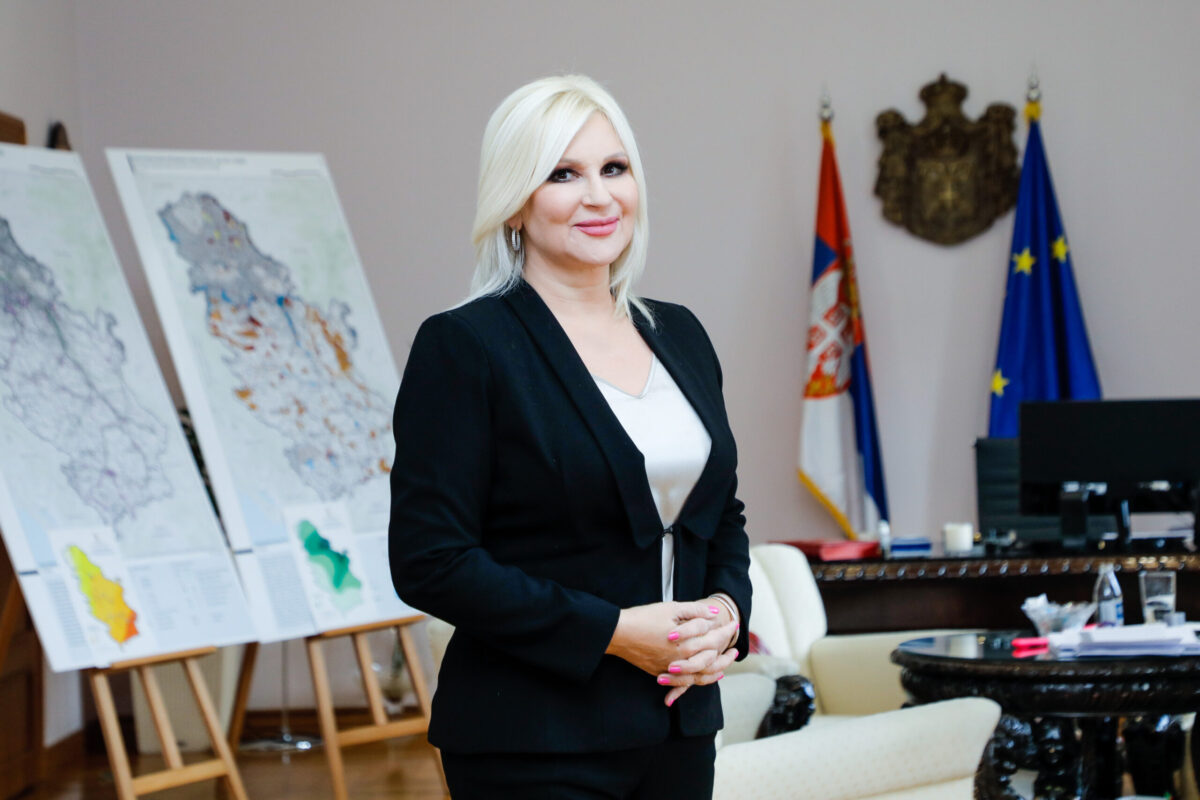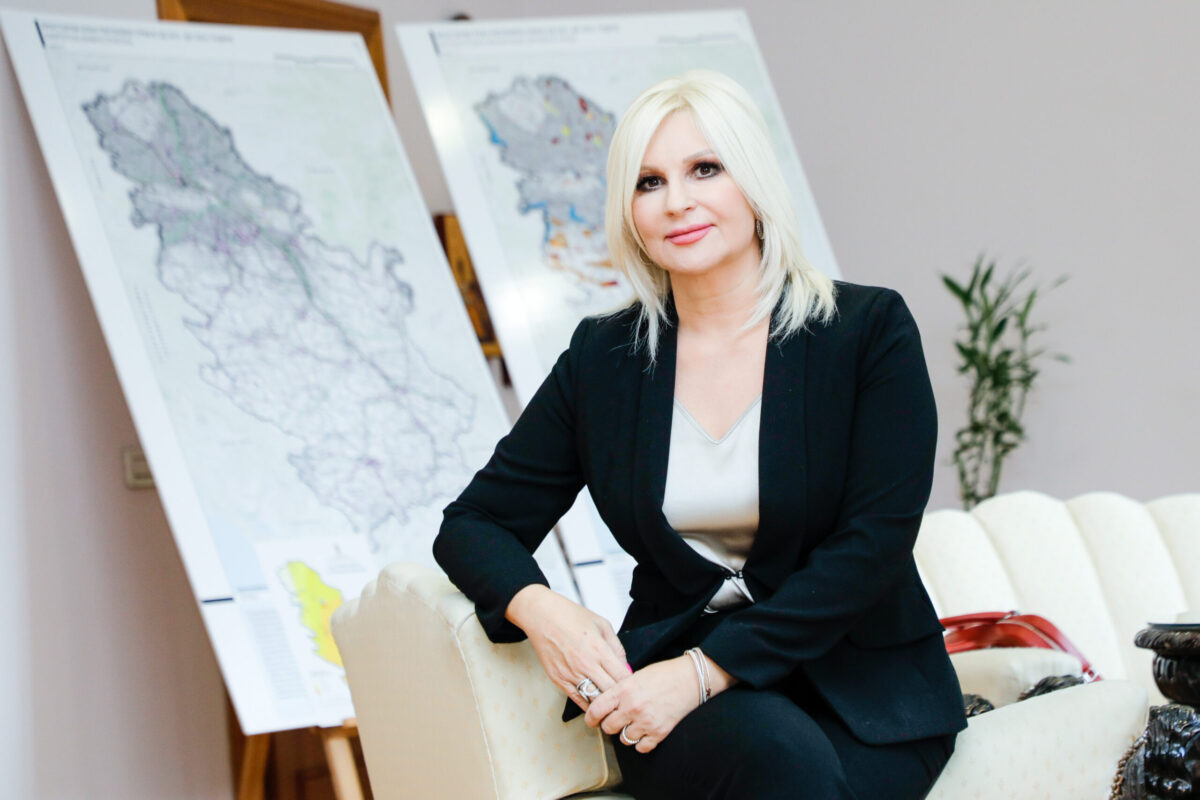Investing in boosting energy efficiency and developing renewable energy sources must be a priority if we want Serbia to have a safe energy supply and be energy independent in the coming decades.
Serbia has been diligently working on implementing the Green Agenda. In her interview, Professor Zorana Mihajlović, PhD, Deputy Prime Minister of the Republic of Serbia and Minister of Mining and Energy, talks about energy security, renewable energy sources (RES), energy efficiency in Serbia and diversification of energy-supply routes.

In Prague, you stated that energy security and independence are priorities for all countries. How is Serbia standing on this issue?
Energy security is currently the number one topic in the world, as a lack of energy security leads to lax national security and hinders economic development. This is especially visible in crises, which bring to the forefront all existing weaknesses and issues that have been pushed under the carpet, so to speak.
It is a great pity that energy was managed by the ministry that was ‘dormant’ in previous years and that many of these things were not initiated much earlier. If that happened, today we would have a different situation relating to the diversification of natural gas supply and the power grid. The Niš-Dimitrovgrad gas pipeline project has been talked about for the past 10 years, and it should have been built even before the current Ministry was formed. And yet, the work on this pipeline, started this year. Also, no new power plants have been built in Serbia for over 30 years, and in previous years. The construction should have been much faster and a lot more should have been invested in the overhaul.
Results don’t appear out of nowhere but come from hard work, effort and dedication. This is how the previous ministry has been working and thanks to that, after almost 30 years, Corridor 10 was finally completed, the Miloš Veliki motorway was built and commissioned and the Belgrade-Budapest high-speed railway project was launched. Also, we now have three international airports in Serbia. I believe that similar results can be achieved in the energy sector too because we have already laid the foundation for a completely different energy sector in the past year and a half, thanks to a new legislative framework, a new investment plan and the fact that we started drafting strategic documents.
Has Serbia already taken the first steps by creating a new legislative framework last year, especially when it comes to the use of RES and energy efficiency?
During this Ministry’s term, the authorities have passed a set of new, contemporary laws regulating the energy sector, including the first special Law on the Use of Renewable Energy Sources, a new Law on Energy Efficiency and Rational Use of Energy, and amendments to the Energy Law. Based on these changes, Serbia has been actively involved in the green energy transition, not only as a state but also through citizen participation. A national programme to increase energy efficiency in households has been launched too, where together with local governments, we have provided financial support to people who wish to replace doors and windows in their houses, improve insulation, and replace boilers with more energy-efficient ones. The option of buyer-producer is also stipulated in the new Law on the Use of Renewable Energy Resources, whereby individuals can produce electricity for their own needs by installing solar panels, with the help of subsidies, and through joint action with towns and municipalities.
Investing in boosting energy efficiency and developing renewable energy sources must be a priority if we want Serbia to have a safe energy supply and be energy independent in the coming decades.
Under the auspices of the energy transition, our task is to provide a different structure of the energy mix, which will ensure that we have enough energy for development and a healthy environment. We will be embarking on a gradual exit from so-called dirty technologies in the next few decades, and at the same time, we are going to build new energy capacities much faster, primarily reversible hydropower plants and RES, while providing enough base energy for the stability of the power system.

How far have we come in the process of drafting an integrated climate and energy plan and new energy development strategies?
For the first time, one document – the Integrated Climate and Energy Plan – contains goals that include increasing energy efficiency, increasing the share of RES in total energy produced and reducing greenhouse gas emissions.
With this document, which will be harmonized with the new energy development strategy, we will adjust our goals to the relevant UN conventions and EU and Energy Community policies, and be part of global efforts in the fight against climate change. But more importantly, we are pledging to present and future generations that we will do everything that is required for Serbia to be a country that has enough energy for its citizens and businesses while preserving and improving the environment.
Serbia has been actively involved in the green energy transition, not only as a state but also through citizen participation.
On the back of a number of proposed scenarios, the working group that is engaged in writing this document has so far come up with six working scenarios that do not include nuclear energy, five working scenarios with nuclear energy and one scenario that has goals equal to those in the EU. The Group has also analyzed how to ensure our energy security, primarily through greater participation of RES in energy production. We will put these scenarios up for a public discussion to hear the proposals and suggestions from everyone – the business sector, universities, civil society and citizens.
The diversification of both supply routes and suppliers has been initiated in the gas sector. What benefits will Serbia gain because of that?
Only a year and a half ago, Serbia got gas from only one direction, that is Hungary, which made our country extremely vulnerable in case of any disturbances. Today, we have the Balkan Stream gas pipeline, which ensures a diverse gas supply, and we have started the construction of a new Niš-Dimitrovgrad gas interconnection, which will enable the country to receive gas from other suppliers. With the completion of the new gas pipeline next year, we will be able to get the gas from the Caspian region to Serbia and gas from the LPG terminal in Alexandroupolis, as well as gas from the future sources, such as the East Med pipeline.
What is the current situation in Serbia in terms of energy stability?
Serbia has sufficient quantities of electricity, heat, gas and other energy sources to supply the domestic market. On the one hand, we have ensured a secure and stable supply, and on the other, measures have been implemented to mitigate the consequences of rising global prices on both our companies and citizens. The energy crisis is a global one and we don’t have a great influence on it. What we can do and are working on is to expedite investments in new capacities, primarily in the power industry and to prepare for all options. In the cases where we are import-dependent, we need to work on increasing gas, crude oil and crude oil derivatives reserves, to be ready to deal with possible disruptions.
Which country in the world is currently a world leader in energy diversification and a role model?
Serbia became more actively involved in the energy transition process last year. Although it is not a good thing that we have started this process later than we should have, it allows us to use the experiences of all those countries which are ahead of us in this process. In addition to exchanging experiences with everyone from whom we can learn something, we need to be open to every country that is interested in cooperation in project implementation, and this is always one of the topics in meetings with ministers from other countries.
What are the current prospects for solving problems in Europe and the world, in the light of the Ukrainian crisis?
It is certain that after the crisis in Ukraine subsidies, nothing will be the same in Europe and the world, and that there will be consequences for both political relations and the economy. We have managed to preserve energy stability throughout this crisis, but we must reckon with the fact that there will still be challenges and that we must be ready for them. This means that we must be much more efficient, especially in investments, but also in introducing changes that are necessary for the functioning of our energy system. In crises, you pay a high price for everything that you have not done on time, and energy is the most expensive when you don’t have enough of it.
Measures have been implemented to mitigate the consequences of rising global prices on both our companies and citizens.
What are regional relations like at the moment and what are further plans for energy diversification in the Balkans?
In addition to the ongoing construction of the Niš-Dimitrovgrad gas pipeline, our goal is to link with gas interconnections in Romania, Bosnia and Herzegovina, Montenegro, Croatia and North Macedonia, as well as to work on increasing our country’s natural gas storage capacity. With the increase of obligatory reserves of crude oil derivatives, where we have already achieved significant progress, in this way, Serbia would substantially increase its own energy security, but also contribute to greater security of supply in the region. Furthermore, it is important to establish various mechanisms in the region to coordinate actions in the event of supply disruptions, including crisis planning. Regional connectivity is key to increasing our energy security, as well as fortifying our resilience to external shocks that we must count on if we want to be ready for them if they happen.